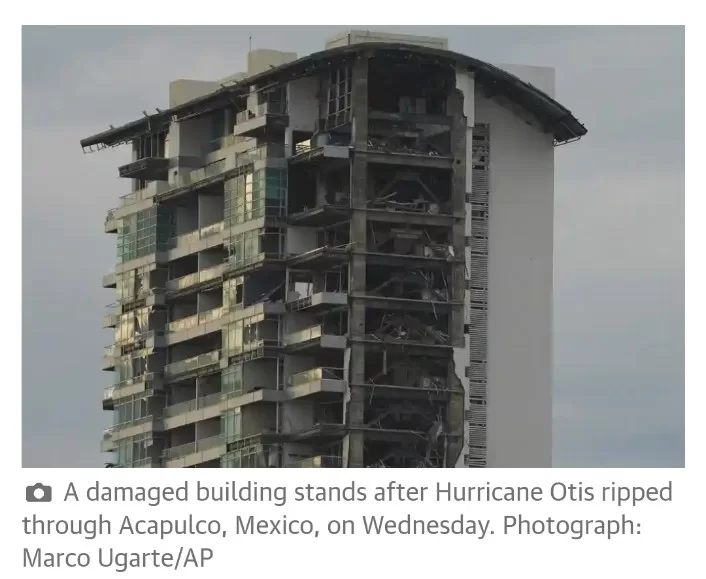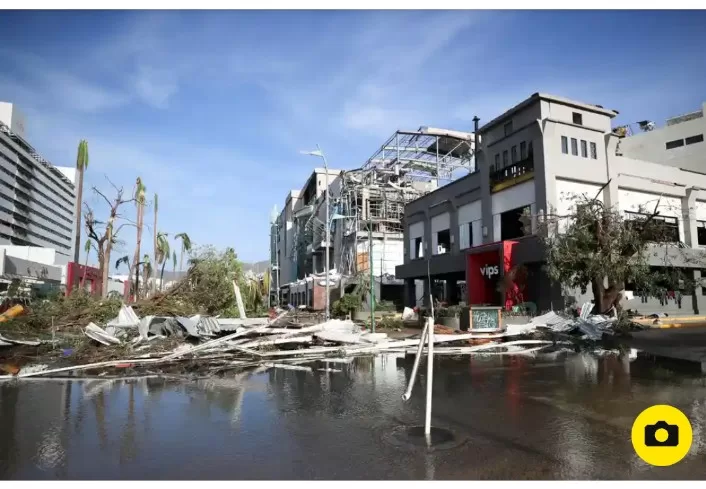Acapulco, Mexico – In a devastating turn of events, Hurricane Otis, a menacing Category 5 storm, wreaked havoc on the picturesque resort city of Acapulco, Mexico. As of October 26, 2023, the aftermath of this powerful natural disaster has left at least 27 people dead, with four individuals still unaccounted for.
The relentless force of Hurricane Otis inundated streets, mercilessly tore off rooftops from homes and hotels, and disrupted all communication, road, and air access to the beleaguered city. Fallen phone lines and electricity cables compounded the crisis, hampering prompt damage assessment and rescue efforts.
Mexican President Andrés Manuel López Obrador expressed his deep concern, vowing to expedite power restoration and recovery operations in the wake of this catastrophic event. He described the destruction in Acapulco as “truly disastrous” during a press conference.
The visual landscape of Acapulco has been irrevocably altered, with the once elegant beachfront hotels now reduced to shattered remnants, their windows blown out in the ferocity of the Category 5 tempest. Early reports depicted a scene of extensive devastation, including toppled trees and power lines submerged in extensive floodwaters.
A sense of frustration permeates Acapulco as authorities grapple with the enormity of the crisis. While approximately 10,000 military personnel were dispatched to the area, they are grappling with the monumental task of clearing tons of mud and fallen trees that now obstruct the city’s streets.
A glimmer of hope emerged as government electricity company trucks arrived in Acapulco, but the daunting challenge of restoring power persists, with electricity lines submerged in mud and water. Tragically, the hurricane’s abrupt intensification caught many residents and tourists off guard, leaving them with inadequate shelter and limited time to prepare.
One harrowing account came from Jakob Sauczuk, a visitor who found himself huddled with friends in a beachfront hotel when Hurricane Otis struck. “We laid down on the floor, and some between beds,” Sauczuk recounted. “We prayed a lot.”
Pablo Navarro, an auto parts worker, took shelter in a 13th-story hotel room, fearing for his life as the wind relentlessly battered the building. “I took shelter in the bathroom, and thankfully the door held,” he recalled. “But there were some rooms where the wind blew out the windows and the doors.”
Efforts to restore the main highway connecting Acapulco to the state capital, Chilpancingo, and Mexico City are underway, but progress has been slow. The city’s commercial and military airports remain severely damaged, impeding the resumption of flights.
Drone footage from Foro TV revealed the extent of the disaster, showing Acapulco’s Diamond Zone, an oceanfront area teeming with hotels and restaurants, submerged beneath a vast expanse of brown water, with boulevards and bridges hidden from view.
The rapid transformation of Hurricane Otis from a tropical storm to a catastrophic Category 5 hurricane took many by surprise. Brian McNoldy, a hurricane researcher at the University of Miami, described the event as a “nightmare,” emphasizing that being unprepared for such a powerful hurricane is a rare and devastating occurrence.
As Acapulco grapples with the aftermath of Hurricane Otis, the resilience and determination of its people will undoubtedly be put to the test. International support and solidarity will be essential in the long road to recovery.







